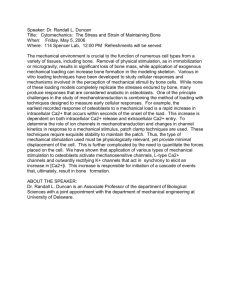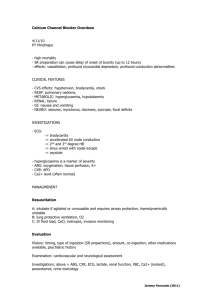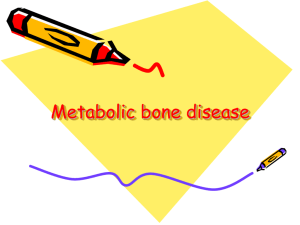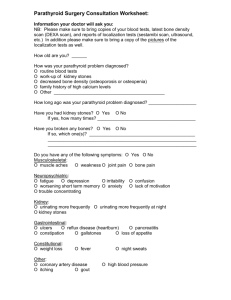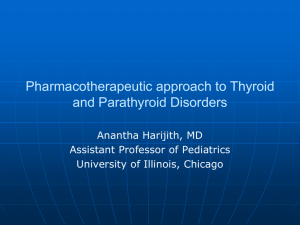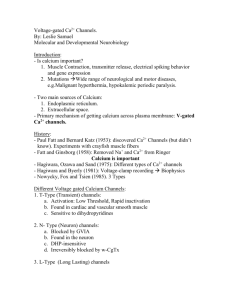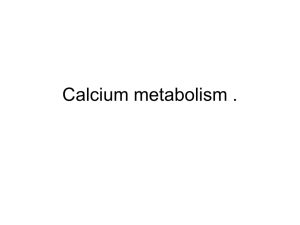L8-9 The Parathyroid Gland & Calcium Homeostasis2015
advertisement
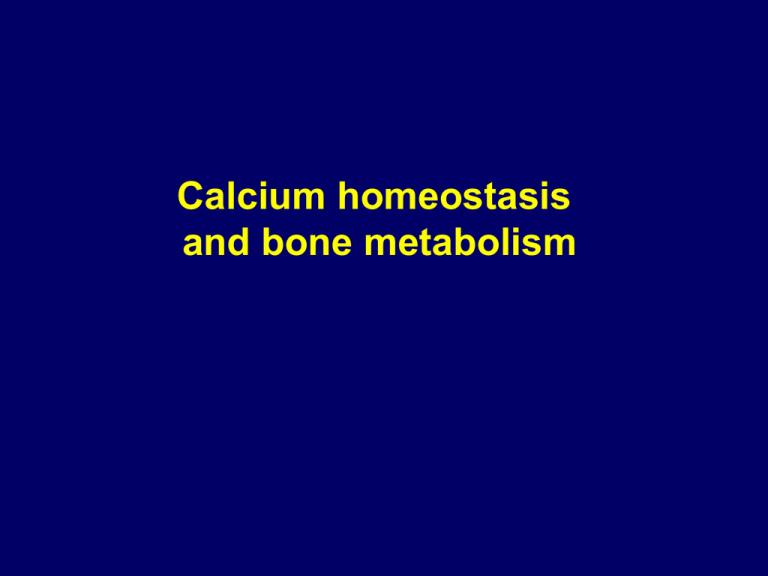
Calcium homeostasis and bone metabolism Regulation of Calcium Metabolism • Minerals; serum concentration – Calcium (Ca2+) = 2.2-2.6 mM/L (total) – Phosphate (HPO42-) = 0.7-1.4mM/L • Organ systems that play an import role in Ca2+ metabolism – Skeleton – GI tract – Kidney • Calcitropic Hormones – – – – Parathyroid hormone (PTH) Calcitonin (CT) Vitamin D (1,25 dihydroxycholecalciferol) Parathyroid hormone related peptide (PTHrP), is markedly elevated in humoral hypercalcemia of malignancy ( sq. cell carcinoma of the lung). The total serum Ca2+ conc. is normally about 10mg/dl. Free ionized Ca2+ is about 50% of the total = (5mg/dl). • Increase in protein con. → ↑ in total Ca2+ conc. • Decrease in protein con. → ↓ in total Ca2+ conc. • The effects on ionized Ca2+ conc. are insignificant. • Changes in anion con. alter the ionized Ca2+ con. e.g. • ↑ plasma phosphate con. → ↑ in the conc. of Ca2+ complexd to phosphate → ↓ ionized Ca2+ con. Ca2+ affects the Na⁺ permeability of nerve membranes. ↓ plasma Ca2+ → Generation of spontaneous action potentials in nerves → tetany • Acid-base abnormalities alter the ionized Ca2+ con. by changing the fraction of Ca2+ bound to plasma albumin. • Albumin has negatively charged sites, which can bind either H+ ions or Ca2+ ions. • Acidosis Alkalosis HH Albumin • H Ca++ Ca++ Ionized [Ca2+ ] HCa++ Ca++ Albumin Ca++ Ca++ Ionized [Ca2+ ] Hyperventilation → Respiratory alkalosis → ↓ ionized Ca2+ → Tetany. Calcium Homeostasis Parathyroid gland Skeleton Ca++ Intestine Vitamin D Kidneys Calcium homeostasis storage bone kidney calcium deposition Blood Ca++ calcium resorption 1000 g Ca++ stored in bone intake Ca++ absorbed into blood excretion Ca++ lost in urine Calcium in the diet calcium lost in feces small intestine Bone • Inorganic (67%) – Hydroxyapatite 3 Ca10(PO4)6(OH)2 – There is some amorphous calcium phosphate • Organic (33%) component is called osteoid – Type I collagen (28%) – Non-collagen structural proteins (5%) – Growth factors and cytokines (Trace) • Bone undergoes continuous turnover or remodeling throughout life – About 20% of bone is undergoing remodeling at any one time. Calcium cycling in bone tissue • Bone formation • Osteoblasts (bone builders) Synthesize a collagen matrix that holds Calcium Phosphate in crystallized form. Once surrounded by bone, become osteocyte. • Bone resorption Osteoclasts (bone breakers) Change local pH, causing Ca++ and phosphate to dissolve from crystals into extracellular fluids. Functions of Calcium • • • • • • • • Total serum calcium 2.15 - 2.6 mmol/L Regulate neuromuscular excitability Blood coagulation Secretory processes Membrane integrity Plasma membrane transport Enzyme reactions Release of hormones and neurotransmitters • Bone mineralization Phosphorus • Important role in cellular metabolism • Source of energy in cellular reactions • Component of phospholipids in membranes Inorganic constituents of bone %age of total body content constituent Present in bone Calcium 99 Phosphate 86 Carbonate 80 Magnesium 50 Sodium 35 Water 9 The Parathyroid Hormone Secreted by the parathyroid glands. Stimulated by hypocalcaemia. The Parathyroid Glands. (a) The location of the parathyroid glands on the posterior surfaces of the thyroid lobes. (The thyroid lobes are located anterior to the trachea). (b) Both parathyroid and thyroid tissues. (c) Parathyroid cells. Actions of Parathyroid Hormone Necessary for fine control of ionized serum Ca2+ levels. – It increases Ca2+ – It decreases Pi • Parathyroid hormone acts directly on bone to stimulate resorption and release of Ca2+ into the extracellular space (slow) • Two effects in kidney – Parathyroid hormone acts directly on kidney to increase calcium reabsorption and phosphate excretion (rapid) – Stimulates transcription of 1-alpha hydroxylase enzyme for Vitamin D activation in kidney • Vitamin D increases calcium and phosphate absorption from intestine. Calcitonin Secreted by the parafollicular or C-cells of the thyroid gland. Stimulated by hypercalcaemia. Lowers Ca2+ in blood Promotes deposition of Ca2+ into bone (inhibits osteoclasts) Promotes renal excretion of Ca2+ Vitamin D Synthesized by the body or taken in food. 7- Dehydrocholestrol (in skin) + Ultraviolet light → Vit. D₃ (inactive form). Hydroxylation of Vit. D₃ first in the Liver → 25, hydroxycholicalciferol (inactive form). Second hydroxylation of Vit.D₃ in the kidneys → 1,25 dihydroxycholicalciferol (active form). 1,25 Vitamin D3 • • • • • Increases Ca2+ uptake from the gut Increase transcription and translation of Ca2+ transport proteins in gut epithelium UV Minor roll: also stimulates osteoclasts Increase Ca++ resorption from bone Cholesterol precursor 7-dehydrocholesterol Vitamin D3 25 Vitamin D3 1,25 Vitamin D3 Low plasma Ca2+ increase kidney enzymes Other regulator of Ca2+ homeostasis Estrogens: Stimulate osteoblast activity , limits osteoclast activity, and enhance PTH secretion. Estrogens changes the set point of PTH cells in the parathyroid so a greater reduction of Ca2+ is needed to increase PTH secretion so: Estrogen decreases Ca2+ loss from bones. Ca2+ homeostasis in pregnancy and lactation The daily required dose of Ca2+ is greatly increased during pregnancy. 30 grams of Ca2+ are transferred to the fetus and lost in urine during pregnancy. Bone turn over is increased during pregnancy → osteoporosis especially hip bone. 280 - 800 mg of Ca2+ is lost in breast milk per day during lactation. The mother compensate by: 1- ↑ intestinal absorption 2- ↓ renal excretion 3- ↑ bone resorption Hypoparathyroidism Commonly occur accidentally after surgical removal of the thyroid gland → Latent or overt tetany. Characterized by hypersensitivity (Low threshold) of nerves and muscles. Can be demonstrated by two signs: Chvostek’s sign: Tapping the facial nerve as it emerge from the parotid gland In front of the ear → Contraction of the facial muscles. Trousseau’s sign: Arresting blood flow to the forearm for few minutes → Flexion of the wrist, thumb and metacarpophalangeal joints. Hypocalcaemia Symptoms: • Chvosteks and Trousseau’s signs • Neuromuscular excitability • Tetany • Paresthesia • Seizures - Hyperfunction Hypofunction hypercalciemia hypophosphatemia hyperphosphaturia osteoporosis Accumulation of Саlcium in tissues - hypocalciemia hyperphosphatemia hypophosphaturia tetanus Causes of Hypocalcaemia Hypoparathyroid Nonparathyroid PTH Resistance Postoperative Vitamin D deficiency Pseudohypoparathyroidism Idiopathic Malabsorption Post radiation Liver disease Kidney disease Vitamin D resistance Pseudohypoparathyroidism • Symptoms and signs – Hypocalcemia – Hyperphosphatemia – Characteristic physical appearance: short stature, round face, short thick neck, obesity, shortening of the metacarpals – Autosomal dominant • Resistance to parathyroid hormone • The patients have normal parathyroid glands, but they fail to respond to parathyroid hormone or PTH injections • Symptoms begin in children of about 8 years – Tetany and seizures – Hypoplasia of dentin or enamel and delay or absence of eruption occurs in 50% of people with the disorder • Treatment: vitamin D and calcium Pseudohypoparathyroidism Short stature, enamel hypoplasia Congenital Hypoparathyroidism • Hypoplasia of the teeth, shortened roots, and retarded eruption Case Study • • • • A 27 years old man presents to his physician 3 weeks after his thyroid surgically removed for a thyroid cancer. However, since he went home from the hospital, he noticed painful, involuntary muscular cramping. He also felt numbness and tingling around his mouth & in his hands and feet. His parents said that he was irritable for the last 2 weeks. He is on levothyroxine medication. On examination • • • He has a well-healing thyroidectomy scar & no palpable masses in the thyroid bed. Blood pressure cuff inflated above the systolic pressure induces involuntary muscular contracture in the ipsilateral hand after 60 seconds (Trousseau`s sign) Tapping on the face interior to the ears cause twitching in the ipsilateral corner of the mouth (Chevostek`s sign) Lab Investigations: Calcium: 5.6 mg/dl (N: 8.5 – 10.2) Albumin: 4.1 g/dl (N: 3.5 – 4.8) PTH: < 1 pg/ml (N: N: 11 – 54) DIAGNOSIS The parathyroid glands were removed during thyroidectomy PTH undetectable Hypocalcemia Clinical Manifestations of hypocalcemia (increased reflexes & muscular cramping) Causes of Hypercalcemia • Hyperparathyroidism and Malignant neoplasms account for majority of hypercalcemia • Neoplasms most frequently associated with hypercalcemia: Breast cancer, lung cancer and multiple myeloma • Most hypercalcemias in malignancy are caused by humoral hypercalcemia of malignancy (↑ PTHrP). • Single adenomas of the parathyroid gland account for 75% of primary hyperparathyroidism associated with hypercalcemia. Parathyroid Hormone related Peptide (PTHrP) Can activate the PTH receptor Plays a physiological role in lactation, possibly as a hormone for the mobilization and/or transfer of calcium to the milk May be important in fetal development May play a role in the development of hypercalcemia of malignancy – Some lung cancers are associated with hypercalcemia – Other cancers can be associated with hypercalcemia Clinical Manifestations of Hypercalcemia • “Stones” • “Bones” • “Abdominal moans” • “Psychic groans” • Neuromuscular • Cardiovascular • Other Clinical Manifestations of Hypercalcemia • Renal “stones” – Nephrolithiasis – Nephrogenic DI: polydipsia and polyuria – Dehydration – Nephrocalcinosis Clinical Manifestations of Hypercalcemia • Skeleton “bones” – Bone pain, arthralgias – Osteoporosis of cortical bone such as wrist – In primary hyperparathyroidism: Subperiosteal resorption, leading to osteitis fibrosa cystica with bone cysts and brown tumors of the long bones Clinical Manifestations of Hypercalcemia • Gastrointestinal “abdominal moans” – Nausea, vomiting – Anorexia – weight loss – Constipation – Abdominal pain – Pancreatitis – Peptic ulcer disease Clinical Manifestations of Hypercalcemia • “Psychic groans” – Impaired concentration and memory – Confusion, stupor, coma – Lethargy and Fatigue Clinical Manifestations of Hypercalcemia • Neuromuscular – Reduced neuromuscular excitability and muscle weakness – Easy fatigability and muscle weakness more common in hyperparathyroidism than other hypercalcemic conditions • Clinical features of hyperparathyroid myopathy: – Proximal muscle weakness, wasting and mild nonspecific myopathic features on electromyogram and muscle biopsy Clinical Manifestations of Hypercalcemia • Cardiovascular – Shortened QT interval on electrocardiogram – Cardiac arrhythmias – Vascular calcification Clinical Manifestations of Hypercalcemia • Other – Itching – Keratitis – Conjunctivitis – Corneal calcification, band keratopathy – Carpal tunnel syndrome has occasionally been associated with hyperparathyroidism Metabolic Diseases of Bones RICKETS Normal formation of the collagen matrix BUT Incomplete mineralization (poor calcification) ↓ Soft Bones ↓ CLINICALLY: Bone Deformity (Rickets) OSTEOMALACIA Demineralization (poor calcification) of preexisting bones ↓ CLINICALLY: More Susceptibility to Fracture Vitamin D deficiency: Rickets • Inadequate intake and absence of sunlight • The most prominent clinical effect of Vitamin D deficiency in adults is osteomalacia, or the defective mineralization of bone matrix. • Vitamin D deficiency in children produces rickets leading to (bow-legged) due to weight bearing on the legs. • A deficiency of renal 1α-hydroxylase produces vitamin D-resistant rickets – Sex linked gene on the X chromosome – Teeth may be hypoplastic and eruption may be retarded Images of Rickets Wrist expansion: cupping and fraying of hypertrophied metaphyseal plate Bone demineralization and deformity Rachitic Rosary Rotten-stump epiphysis Renal Rickets Renal Osteodystrophy In Chronic Renal Failure Low activity of Renal 1α-hydroxylase Decreased ability to form the active form of vitamin D (1, 25 DHCC will be low) Treatment: 1,25 DHCC (Calcitriol) Laboratory Investigations for the Diagnosis of Rickets & Osteomalacia Investigations to confirm the diagnosis of rickets: Blood levels of 25-hydroxycholecalciferol (25 HCC) Blood calcium, (hypocalcemia) Blood Alkaline phosphatase (ALP) Investigations to diagnose the cause of rickets: Kidney function tests (KFT) Blood 1, 25 dihydroxycholecalciferol (1, 25 DHCC) Blood PTH Others i.e. molecular genetics (if indicated) Osteoporosis • Most prevalent metabolic bone disease in adults • It means reduction in bone mass. i.e. bone matrix composition is normal, but it is reduced. • Typically silent (without symptoms) until it leads to fracture at a minimal trauma. Most affected: vertebral compression (may be asymptomatic) & hip fractures (requires surgery in most cases). • Post-menopausal women lose more bone mass than men (primary osteoporosis) Osteoporosis Sequelae of Osteoporosis Secondary Osteoporosis Risk Factors Risk Factors for osteoporosis: Advanced age (esp. in females) Certain Drugs Family history of osteoporosis or fractures Immobilization Smoking Excess alcohol intake Cushing’s syndrome Long term glucocorticoids therapy Hyperparathyroidism Hyperthyroidism Vitamin D disorders Certain malignancies Any Questions?
